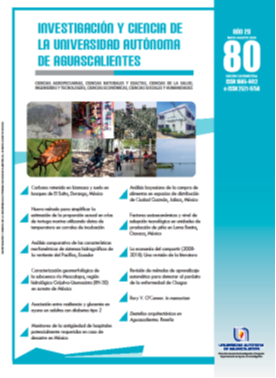Monitoring age of hospitals potentially required in case of disaster in Mexico
DOI:
https://doi.org/10.33064/iycuaa2020803004Keywords:
safety, risk, health, construction, ObservatoryAbstract
The occurrence of recent disasters in Mexico made evident the need to assess the safety of the critical infrastructure of the health sector. Given the relatively recent development of building codes and guidelines to make hospitals safe from disasters, this article explores the obstacles to increase the safety of hospitals considering their construction period. Therefore, age and floor space ratio were used as indicators to analyze hospitals that are currently under process of certification in the Safe Hospital program in Mexico. It is observed that only a minority of hospitals are of recent construction and most of these hospitals are subject to a constant physical expansion. Therefore, an Observatory is proposed to identify vulnerabilities associated with age and gradual reduction of open space. This would be useful to evaluate the feasibility of receiving a large number of patients after a mass casualty disaster.
Downloads
References
de Salud Pública, 40 (3), 174-180.
• Coordinación General de Protección Civil. (2011). Universo de hospitales clasificados como de alta complejidad y alto nivel resolutivo (rojos) con corte al 31 de diciembre de 2011 programa hospital seguro [Tabla en pdf]. Recuperado de www.proteccioncivil.gob.mx/work/models/ProteccionCivil/Resource/59/2/images/lhcr.pdf
• Google Earth. (s. f.). Hospital General Agustín O’Horan, Mérida, Yucatán, México [Fotografía aérea]. Recuperada de earth.google.com
• Loyo-Varela, M., & Díaz-Chazaro, H. (2009). Hospitales en México. Cirugía y Cirujanos, 77(6), 497-504.
• Montejano-Castillo, M., & Moreno-Villanueva, M. (2018). Hospitals safe from disasters: A glimpse into the Mexican coastal zones. International Journal of Safety & Security Engineering, 8(2), 329-341.
• Organización Panamericana de la Salud. (1996). Conferencia internacional sobre mitigación de desastres en instalaciones de salud. Recomendaciones. Washington, D. C., EE. UU:
Oficina Sanitaria Panamericana-Oficina Regional de la OMS. Recuperado de http://helid.digicollection.org/en/d/J063s/4.html
• __________ (2008). Lista de verificación de hospitales seguros [Formato en pdf]. Recuperado de https://www.gob.mx/cms/uploads/attachment/file/58617/hs_06.pdf
• Rautela, P., Girish, C. J., & Bhupendra, B. (2011). Seismic vulnerability of the health infrastructure in the Himalayan township of Mussoorie, Uttarakhand, India. International Journal of Disaster Resilience in the Built Environment, 2(3), 200-209. doi: 10.1108/17595901111167088
• United Nations International Strategy for Disaster Reduction. (2007). Hyogo Framework for Action 2005-2015: Building the resilience of nations and communities to disasters. Geneva, Switzerland: UNISDR.
• _________ (2015). Sendai framework for disaster risk reduction 2015–2030. Geneva, Switzerland: UNISDR.
• World Health Organization. (2015). Hospital safety index: Guide for evaluators (2nd. ed.). Geneva, Switzerland: WHO.
• Zeballos, J. L. (1993). Effects of natural disasters on the health infrastructure: Lessons from a medical perspective. Bulletin of the Pan American Health Organization, 27(4), 389-396.
Downloads
Published
Versions
- 2020-06-30 (2)
- 2020-06-30 (1)
How to Cite
Issue
Section
Categories
License
Las obras publicadas en versión electrónica de la revista están bajo la licencia Creative Commons Atribución-NoComercial-CompartirIgual 4.0 Internacional (CC BY-NC-SA 4.0)









